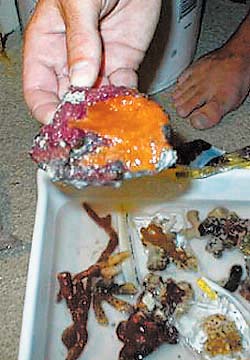Advertisement - Click to support our sponsors.


New species of marine sponges, rapidly growing alien weeds, shipwrecks, golden-sand beaches, big-headed ants and abundant sea life. Nature’s sovereignty
rules northwestern
Hawaiian islesBy Helen Altonn
Star-BulletinThose are only a few of the findings being reported almost daily by state and federal scientists surveying ecological resources in the Northwestern Hawaiian Islands.
Their discoveries are greatly altering the picture of the remote islands and reefs that span 3,523 square miles.
"We expected surprises," said Barbara Maxfield, chief of the Division of External Affairs, Pacific Islands Ecoregion, U.S. Fish and Wildlife Service. "They're finding new species, which is absolutely wonderful."
The research expedition to the islands began Sept. 8, with the marine scientists traveling aboard the Townsend Cromwell, a National Oceanographic and Atmospheric Administration vessel. They were joined later in the month by researchers aboard the chartered ship Rapture.
The Rapture will return next Thursday and the Cromwell in late November after cleaning up marine debris in the islands.

The reef system in the Northwestern Hawaiian Islands includes Nihoa and Necker Islands, Gardner Pinnacles, Maro Reef, Laysan Island, French Frigate Shoals, Lisianski Island, Pearl and Hermes Atoll, Midway and Kure Atolls and Emperor Seamounts.Invertebrate zoologist Ralph DeFelice identified 10 new species of colorful marine sponges in one location at Pearl and Hermes Reef.
He acknowledged it's hard to get people excited about sponges. But they are the oldest multicellular animals on earth and living filters in the ocean, he said. They act as the sea's "vacuum cleaners," drawing in and pumping out water. They also contain chemicals valuable in medicine.
Hawaiian Islands Wildlife Refuge manager David Johnson and wildlife biologists Chris Depkin and Eric Lund, meanwhile, mapped alien weeds and other vegetation on Southeast Island at Pearl and Hermes Atoll.

Aggressive weeds, such as verbesina or golden crown beard, have grown rapidly on the island, covering native vegetation. The scientists are concerned this may affect seabird breeding because the weeds are too high and dense for birds to nest.It's important to protect the little 34-acre island because it "is serving a huge ocean ... providing the only place for some of these sea birds to come back to, breed and care for their young," Johnson said.
The researchers also found shipwrecks scattered around Kure Atoll -- "monuments to nature's ultimate sovereignty" -- as well as a "healthy number" of groupers, jacks and sharks at the remote islands. This is in "stark contrast to the shy, scarce populations surviving in the main Hawaiian islands."
"Humans take their toll -- fishing, pollution, habitat destruction," Stephanie Holzwarth, of the National Marine Fisheries Service, reported from the Townsend Cromwell.
"This makes me glad that the president and others are committed to preserving treasures like these intact coral reef ecosystems. That is why we are working our tails off to survey these reefs in the most complete manner possible."
The Paradise Queen II, a longline fishing vessel shipwrecked two years ago on Kure Atoll, is continuing to break apart and deteriorate in Green Island waters, the scientists said. Underwater photographers documented the vessel's impact on the pristine waters.
"Although the wreck doesn't appear to be causing continued harm to marine life, it remains a physical scar and reminder of the effects human impacts can have on wildlife sanctuaries such as Kure," said Ethan Shiinoki, a wildlife expert with the state Department of Land and Natural Resources.
Scientists had both bad and good news about Kure Atoll's 260-acre Green Island, a State of Hawaii Wildlife Sanctuary about 1,175 miles northwest of Honolulu at the extreme northwestern end of the archipelago.
For decades, rats have destroyed nests, eggs and chicks of many birds that nest and breed on the island. The Department of Land and Natural Resources and the U.S. Department of Agriculture began a rat-eradication program in 1993.
After seven years of work and monitoring, there's no sign of the Polynesian rats there now, while Christmas shearwaters, Bonin petrels, wedge-tailed shearwaters and red-tailed tropic birds have increased, Shiinoki said.
However, Bishop Museum entomologist Gordon Nishida and Fish and Wildlife Service seabird biologist Beth Flint found "an incredible number" of big-headed ants -- 26,500 per square meter at sample sites -- overrunning the ecosystem.
"Even more incredible," Nishida said, "is that our count was done on surface ants only. Many other ants in a colony, including the queen, live deeper underground. We have no idea what their numbers might be."
Flint said such ants are "ecosystem-busters ... They'll eat anything that doesn't have a defense." On Kure, these alien ants have no natural predators to control their population, she said, so, "as long as they can find food, their colonies will probably continue to grow."
Researchers need to learn why the ant explosion is occurring and how to control it, Nishida said.
After a series of dives off Kure, Jim Maragos, a coral reef biologist and principal investigator for the Fish and Wildlife Service on the Rapture, called it "an awesome little place."
"The corals, the fish and the charismatic mega-fauna -- the big stuff like monk seals, ulua and sharks -- we found far exceeded our expectations and challenged what we had previously thought about this place."
Holzwarth described "soft, golden-sand beaches" at Laysan Island, with monk seals "lined up like black bean bags along the beach and the thousands of sea birds that nest there."
At Lisianski Island, she said, they dove on coral that "was a mosaic of shapes and colors on the huge pinnacles -- a virtual Neptune's kingdom of coral castles spiraling up through the clear water."
Maxfield said many questions are being posed to the researchers and answered on the Bishop Museum's expedition Web site: http://explorers.bishopmuseum.org/nwhi.